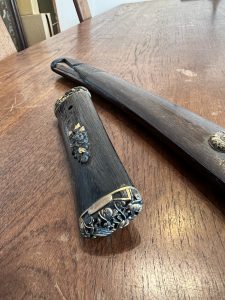刀剣の査定買取でお悩みの方はけっこういます。(愛知県名古屋市千種区姫池通 骨董買取 古美術風光舎)
2024.05.23
みなさまこんにちは、スタッフYでございます。
季節の良くなり、このところご実家などのお片付けのご依頼やご相談も多くなりました。そのなかで少し気になったことに、刀剣などの処分や扱いにお悩みのお客様がいらっしゃいます。
そんな刀剣について少しずつです呟いてみたいと思いますが、本日はまず刀剣とは?からであります。

1.まず、刀剣とはどういうものか。
日本古来の伝統美である『刀』。神々を崇める道具や魔物を退治する魔除けとして、また別の時代では、人を殺める道具として使われてきました。歴史の長い刀剣は現代においては高価な骨董品の中でも『刀剣類』として扱われていますが、さて「刀剣とはどういうもの?」と聞かれると、その定義はちょっと難しく、例えば、『刀』は刀剣という事は簡単に分かりますが、『包丁』は刀剣なのかちょっと悩みますよね。
2.刀剣の定義とは?
刀剣の定義は『刀身』や『剣身』を備えている『武器』の総称でありますが、刀や太刀、日本刀など、刀剣関連には様々な種類がありそれらの種類の総称のことです。もう少し具体的に説明していきますと、「刀剣」と「刃物」は違います。前述にあるように、「刃身があるのであれば刀剣なのであれば、包丁も刀剣では?」と思われるかもしれませんが、包丁は「刃物」に属し刀剣類ではありません。刃をもつもので、刀剣類に属するものには一定の定義が存在し、その定義に属すれば『刀剣』、属さなければ『刃物』と分類されるのですが、肝心な『刀剣類』と『刃物』の違いは何のでしょうか?
3.『刀剣類』とは、銃刀法によると…
第二条 2 /この法律において『刀剣類』とは、刃渡り十五センチメートル以上の刀、槍及び薙刀、刃渡り五・五センチメートル以上の剣、あいくち並びに四十五度以上に自動的に開刃する装置を有する飛出しナイフ(刃渡り五・五センチメートル以下の飛出しナイフで、開刃した刃体をさやと直線に固定させる装置を有せず、刃先が直線であつてみねの先端部が丸みを帯び、かつ、みねの上における切先から直線で一センチメートルの点と切先とを結ぶ線が刃先の線に対して六十度以上の角度で交わるものを除く。)をいう。
つまり、刀剣類とは
・刃渡り15cm以上の刀、やり及びなぎなた刃渡り
・5.5cm以上の剣、あいくち、飛出しナイフ
となり、これ以外のナイフは刀剣類ではなく、刃物に分類され、銃刀法の刀剣類に該当いたしません。銃刀法を見てみると、刀剣類の中に、刃渡り15cm以上の刀「やり」及び「なぎなた」とあります、槍と薙刀に関しては、明らかにその形状で判別できるでしょうが、刀と包丁やナイフの違いは何になるのでしょうか。刀と包丁、ナイフとの違いはその形状で判断するしかなく、切先とつばの付け根を結ぶ線が刀身から外れている場合、つまり反っているものをおおむね刀剣類としているようです。
しかし、反ってはいないものの日本古来の武器である忍者刀は武器であるとの判例があり、刀剣類ですので所持は禁止されています。刀身が反っているということは、どういう意味を持つかと言うと、切るだけでなく突き刺すのに有効な形状をしているということで、これは槍も薙刀も同じです。突き刺すという行為は、切るよりもはるかに深い傷を負わせ、危険で殺傷能力が高いため、武器として認識されているようです。ちょっと話が微妙になってきましたね…。
「で、結局どう分けられるの?」と思われるかもしれませんので非常に簡単に刀剣と刃物の見分け方をまとめますと
・刀剣類 = 武器
・刃物 = 道具
と、理解しておくのがよいのではないでしょうか。だから道具と言える包丁は「刀剣」ではなく「刃物」なのです。
前述にもありますが、刃をもつ形状の変わった武器として、「薙刀」や「槍」がありますが、あれらも刀剣類に属します。殺傷力のもつ刃を持った武器だからなのでしょう。また、刀剣の買取業界においては「鍔」や「拵え」といった刀装具も刀剣類も価値があり買取として扱っていますので、装飾などの価値があるのも刀剣でしょうか。
4.『刀剣類』は注意が必要です。
骨董品でも本物の日本刀を含む『刀剣類』の扱いは大変危険なものです。所持するためには必ず『銃砲刀剣類登録証』が必ず必要になります。この証明書がついている『刀剣類』であれば、骨董品店で購入する際も、友人に証明書と一緒に譲る際にも必要となる大切な証書となります。この登録証、基本的に『刀剣類』についてくるものですので『刃物』には必要ありません。(自宅の包丁に証書はないですよね。)よって、登録証のない『刀剣類』を持っている場合は改めて登録の手続きを行わなければなりませんのでご注意ください。
そして、刀剣には所持することができないものもあります。それは、日本刀をつくる工程に、決められている必要な工程を行わずに製造された刀剣です。刀剣や日本刀を所持するためには、このような事を知っておく必要がありますのでご注意ください。
今日はなんだかひやっとするようなつぶやきでありましたが、私もこのところ美術館で銘刀が気になっており、あの吸い込まれるような風景と刃先に魅了されることも。こうやって刀剣に沼っていくのか…と少し思いましたが、その刃先と同じくその扱いと保管は大変危険で繊細。私にとってはまだ簡単に近づける存在ではないようです。
次回は刀剣の魅力やその買取についてなどなど呟いてまいります。
それではごきげんよう。
*古美術風光舎では刀剣の買取や査定のご相談も承っております。ご自宅ご実家にございます刀剣をどうしようかとお悩みでありましたら、一度ご相談くださいませ。

Hello everyone, this is Staff Y.
As the season is getting better, we have been receiving a lot of requests and consultations regarding the cleanup of family homes and other properties. One of the things that has been bothering us is that some of our customers are having trouble disposing of or handling swords and other such items.
Today, I would like to talk a little about swords.
First of all, what is a sword?
Swords” are an ancient Japanese traditional beauty. It has been used as a tool to worship the gods, as an amulet to ward off demons, and in other times, as a tool to kill people. Today, swords with a long history are treated as “swords” among expensive antiques. For example, it is easy to understand that a “katana” is a sword, but is a “kitchen knife” a sword?
What is the definition of a sword?
The definition of a sword is a generic term for a “weapon” that has a “sword blade” or “sword body,” but there are many different types of swords, such as the katana, tachi, and nihonto.
To be more specific, there is a difference between a “sword” and a “blade”.
As mentioned above, you may be thinking, “If a knife is a sword if it has a blade, then isn’t a kitchen knife also a sword?” However, a kitchen knife belongs to the “cutlery” category and is not a sword. If a knife has a blade and belongs to the sword category, it is classified as a “sword” and if it does not, it is classified as a “cutlery”.
What is the difference between “swords” and “knives”? 3.
Article 2, paragraph 2
In this law, “swords” means swords, spears and naginata with a blade of 15 cm or more in length, swords with a blade of 5.5 cm or more in length, aikuchi, and flying knives (flying knives with a blade of 5.5 cm or less in length that have a device to automatically open the blade to a 45 degree angle or more, and knives with a blade that is not fixed in a straight line with the sheath and the blade. (excluding flying knives with a cutting edge of 5.5 centimeters or less, with a straight cutting edge and a rounded tip of the blade, and with a line connecting a point on the blade 1 centimeter straight from the cutting edge with the cutting edge at an angle of 60 degrees or more to the line of the cutting edge). (2) “Swords” means swords.
In other words, swords are
Swords, javelins, and naginata with blades of 15 cm or more in length
Swords with a blade of 5.5 cm or more in length, aikuchi, and flying knives
Other knives are classified as blades, not swords, and do not fall under the category of swords under the Swords and Swords Law.
The Swords and Swords Law includes the words “yari” and “naginata,” which are swords with a blade of 15 cm or more in length, and the spear and naginata are clearly distinguishable by their shape, but what is the difference between a sword and a knife or kitchen knife?
The only way to tell the difference between a sword and a kitchen knife or a knife is to judge by the shape of the sword. However, there is a precedent that a ninja sword, an ancient Japanese weapon, is a weapon even though it is not warped, and its possession is prohibited because it is a sword.
The fact that the blade is warped means that it is shaped not only to cut, but also to thrust, which is the same for spears and naginata. The act of thrusting seems to be recognized as a weapon because it inflicts a much deeper wound than cutting, and is dangerous and capable of killing. The story is getting a little more subtle….
So, how do we divide the two in the end? So here is a very simple way to distinguish between swords and blades.
Swords = Weapons
Blades = tools
It would be better to understand this as “swords” and “knives”.
Therefore, a kitchen knife, which can be called a tool, is not a “sword” but a “blade.
As mentioned above, there are also “naginata” and “javelin” as weapons with blades of unusual shapes. They are also classified as swords, probably because they have blades with the power to kill.
In the industry of purchasing swords, sword accessories such as “tsubas” and “arrangements” also have value and are treated as swords for purchase.
4. “Swords” should be treated with caution.
Handling swords, including real Japanese swords, is very dangerous, even for antiques. A “Firearms and Swords Registration Certificate” is always required to possess such items. This certificate is an important document that is required when purchasing a sword from an antique store or giving it to a friend with a certificate.
This registration certificate is basically attached to “swords” and is not required for “knives. (You don’t have a certificate for your kitchen knives at home, do you?) (You don’t have a certificate for your knives at home, do you?) Therefore, please note that if you have “swords” without a registration certificate, you will have to go through the registration process again.
And there are some swords that you are not allowed to possess. That is, swords that have been manufactured without the necessary steps that are determined in the process of making Japanese swords. Please note that you need to know these things in order to possess a sword or Japanese sword.
Today’s tweet was somewhat cringe-worthy, but I have also been curious about the famous swords at museums recently, and I am sometimes fascinated by that absorbing scenery and the edge of the blade. I was a little bit surprised to know that this is how I got swamped with swords… but just like their cutting edges, their handling and storage are very dangerous and delicate.
It is not an existence that I can easily approach yet.
So long, and have a good day.
We at Fumikosha are happy to purchase your swords and provide you with consultation. If you are wondering what to do with the swords you have at home or at your parents’ house, please contact us.
*******************
ご実家の整理やお片付けなどをされている方のご相談などが多くございます。
お片付けなどくれぐれもご無理のないようになさってくださいませ。
風光舎では古美術品や骨董品の他にも絵画や宝石、趣味のお品など様々なジャンルのものを買受しております。
お片付けをされていて、こういうものでもいいのかしらと迷われているものでも、どうぞお気軽にご相談下さいませ。
また風光舎は、出張買取も強化しております。ご近所はもちろん、愛知県内、岐阜県、三重県その他の県へも出張いたします。
まずは、お電話お待ちしております。
愛知県名古屋市千種区姫池通
骨董 買取【古美術 風光舎 名古屋店】
TEL052(734)8444
10:00-18:00 OPEN

